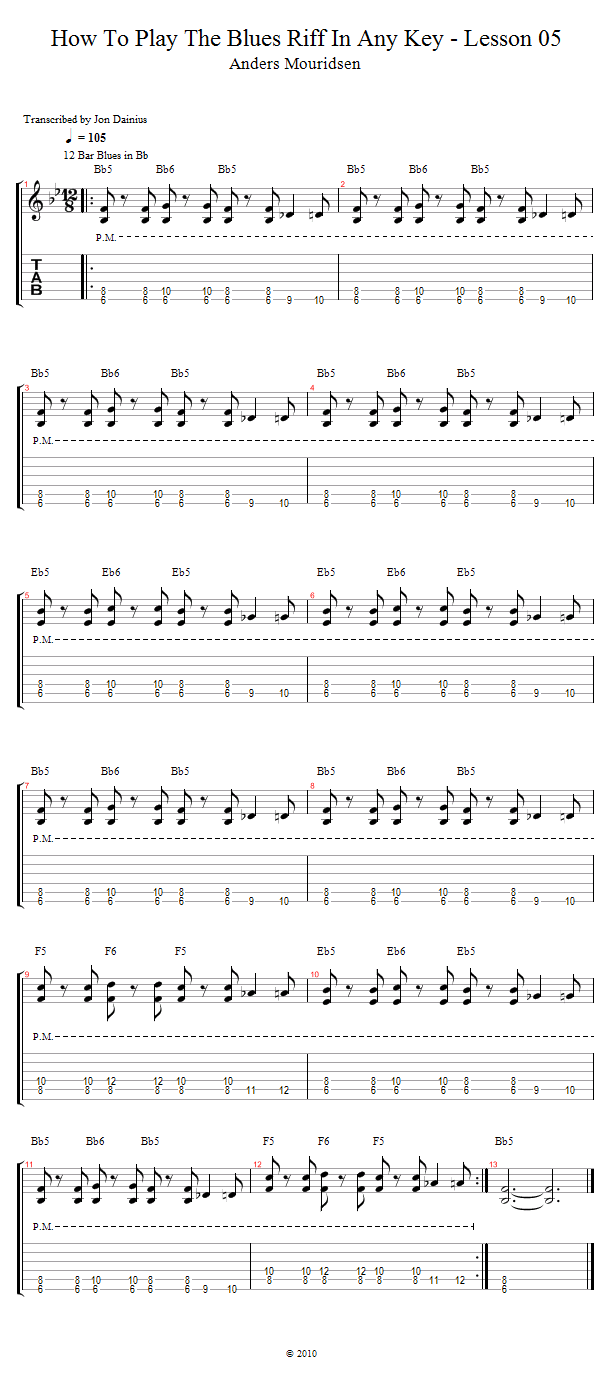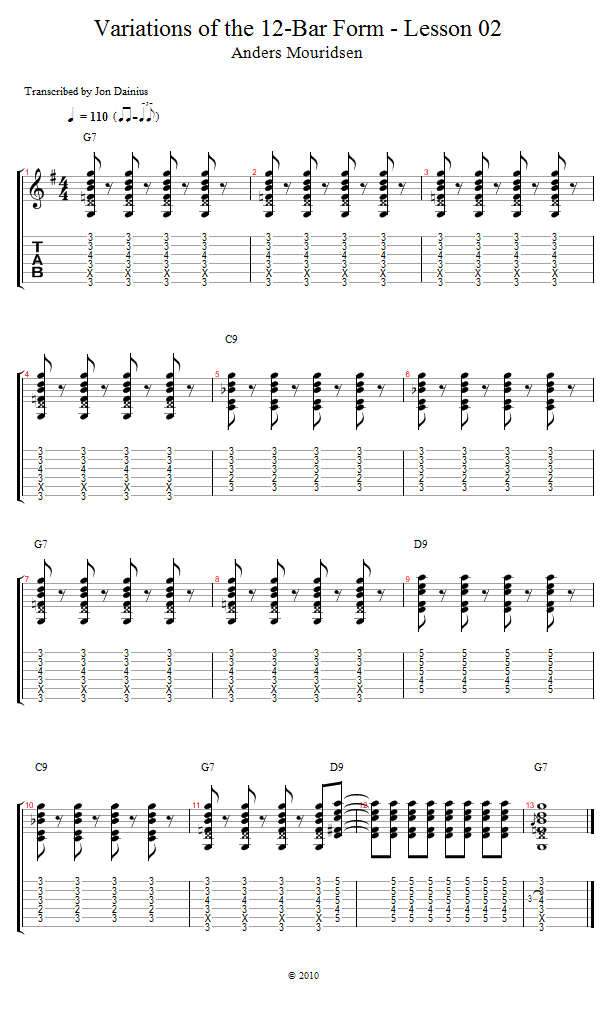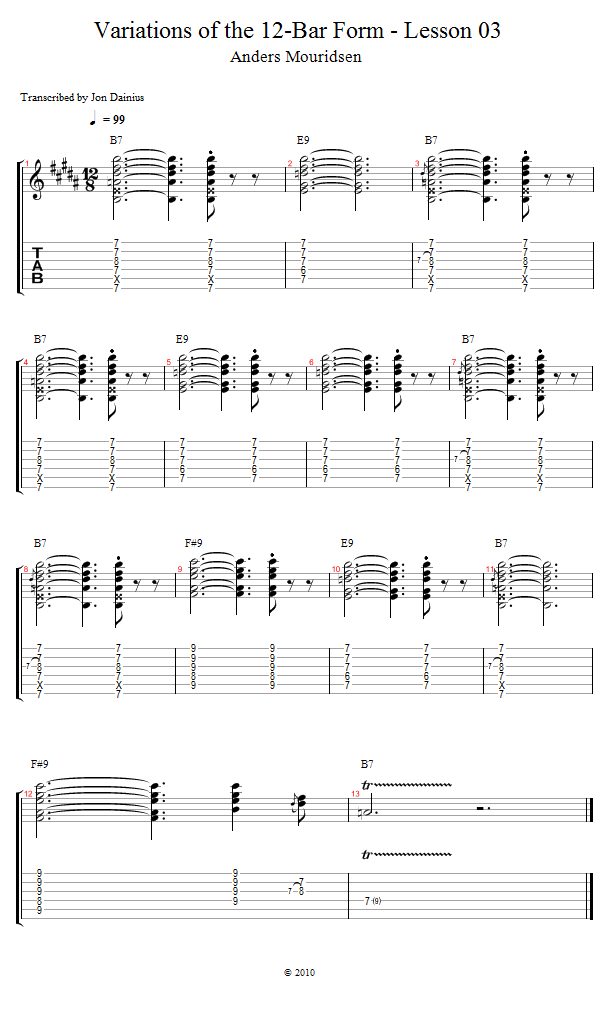Scottoro
Chapter 3: Minor and Dominant Blues
In this chapter we’ll show you the blues progression in minor keys. You’ll learn to add new turnarounds particular to minor keys, moving the progression to different key signatures and voicing blues guitar chords in new ways!
Tutorial: The Minor Blues
In this lesson we are gonna explore the sound of the minor blues. After breaking down the basic chord structure of the 12-bar minor blues form, I will show you how to play it with barre chords. After that we are gonna look at a common “turnaround” variation that you often hear in minor blues, and finally I will show you how to change the key of the minor blues, so that you can adapt the overall chord structure to any given song…
Intro: 12 Bar Variations & Chord Voicings
In this chapter we’re gonna take your blues playing to the next level, by adding the minor blues form and common 12 bar variations to your skill set. We’re also gonna look at alternative chord “voicings” like the jazzy 9 chord, the Hendrix-sounding thumb voicings and the sparse two-note voicings.
Breaking Down the Minor Blues

In this lesson I’m gonna break down the most basic version of a 12 bar minor blues form. After you’ve gotten a chance to get comfortable with the chords and the form, we’re gonna play through it with “the band”.
Minor Blues with Barre Chords

In this lesson I’m gonna show you how to play the 12 bar minor blues form with barre chords. When you get comfortable with this you can play minor blues in any key!
Minor Blues with a Common Turnaround

The variations on the minor blues form seem never ending, but one that you see over and over again is the 12 bar minor blues form with a “Flat VI turnaround”. In this lesson I’ll show you what that means and sounds like, and I’m sure you’ll recognize the sound of it!
Minor Blues in Any Key

In this lesson we’re gonna adapt what you’ve learned so far to a couple of different keys. Don’t think you have to understand the names and numbers like the “bVI-chord”. You don’t even need to know the name of the chord at this point. The most important thing, right now, is that you know how to find it and how it sounds!
Conclusion: Listen For It
In this chapter you’ve gotten a chance to get comfortable with the minor blues form. Try to see if you can recognize this form when you listen to your blues records from now on. But once again, there are about a million variations on this form, so you might hear a “variation of the variation”, but if you start noticing these things you’ll have them all down sooner than later!
Tutorial: How To Play the Blues Riff in Any Key
In this tutorial we are gonna take the blues riff that you learned earlier and adapt it to any given key, all over the neck. Once we have covered the basics of that, we’re gonna use it to play through the 12 bar form with “the band” in different keys. We are also gonna look a cool variation of the riff…
Introduction: The Blues in Any Key
In this tutorial I’m gonna teach you how to adapt the classic blues riff that you learned earlier to any key all over the neck. This can be pretty tricky at first, but once you get it down you can use this riff in Blues, Rock’n Roll and Classic Rock.
Blues Riff: Movin' It Up The Neck!

In this lesson I’m gonna show you how to move the blues riff from the open position and up the neck. This requires some left hand finger stretching that can be pretty hard at first, but you just have to keep doing it and you’ll get there!
Finding the Chords of the 12 Bar Form

In this lesson we’re gonna use the version of the blues riff that you learned in the previous lesson to play through the 12 bar form in a new and strange key: Bb! A lot of blues tunes are played in this key, mainly because it’s an easy key for horn players!
I Chord: Root On The 5th String

Just like you saw it when we were working on the power and barre chords, there will be certain keys where you’ll have to move so high up the neck that it gets really uncomfortable because the frets are so small.
That’s when it can be really handy to voice the I chord with the root on the 5th string instead, and this also applies to the blues riff. Let’s look at how you can find your IV and V chord when this is the case.
Adding The Lick

In this lesson we’re gonna add the “lick” that we covered earlier to the blues riff that can be played in any key. After breaking it down and practicing it, we’ll try it out with the backing track!
Blues Riff in Any Key: Conclusion
Today you’ve learned some basic blues vocabulary that you’ll be using every time you play blues, rock ‘n’ roll, or even classic rock. I know it can be hard to stretch your left hand fingers that far apart, but if you like these styles of music, it’s absolutely worth the work you put into it.
And every time you practice something like this, you’re also improving your overall abilities as a guitar player, which will make it easier to learn other more difficult things down the road!
Tutorial: Alternative Chord Voicings
In this tutorial I’m going to show you some alternative “voicings” of the chords used in the blues. When you arrange the notes of your chords differently, take out or add certain notes, you can get many different sounds and possibilities out of them. In this tutorial we are gonna explore some of these sounds and look at how they are used in the context of the blues.
Introduction to Alt Chord Voicings
The word “voicing” means that you take the notes of a chord and arrange them differently to give a certain chord a different sound. Sometimes that means removing all the unnecessary notes to get a “stripped down” sound, adding certain notes to get a jazzier sound or fingering the notes differently so some fingers are free to do embellishments.
As guitar players we play rhythm guitar 90% of the time, so all the time you spend on things like these is very well spent!
Three Note Voicings

In this lesson we’re gonna strip down our dominant 7 chords to a chord voicing that uses just 3 notes. I’ll show you how to voice the I, IV, and V chord; then we’re gonna try it out with “the band”.
Two Note Voicings

When you play with other instruments, whether it’s playing along with a record or live musicians, you can sometimes count on them to play certain things. One of those things is the root note- that’s the bass players job. This means that we can spell out our dominant 7 chords with just a 2 note chord voicing!
Your Thumb Is There for a Reason!

In this lesson I’ll show you how to fret bass notes with your thumb. This may be really hard to do right now, but once you get comfortable with it, it will open up a world of possibilities. Thumb voicings are extremely useful in blues, but they are also a huge part of Jimi Hendrix’ rhythm guitar playing, Motown, Classic Rock etc.
I’m gonna show you the basic chord voicing and then we’re gonna hear how it sounds with the backing track! We’ll get into all the cool stuff you can use thumb voicings for in level 2…
Introducing the 9 Chord

In this lesson I’m gonna show you a really useful type of chord called a “9 chord”. It’s used in all styles of music, and is particularly useful in the context of the blues.
All it is, is a dominant 7 chord, where you add the 9th scale step (Which is the same as the 2, but up an octave). It has a jazzier sound and is often used for the IV and V chord.
After going through the voicings, we’re gonna play through the 12 bar form using thumb voicings for the I chord and 9 chords for the IV and V chord!
Conclusion to Alt Chord Voicings
Everything we’ve covered today is a part of the basic guitar skills that you need to play almost any style of music. So even though we’re looking at all of this in a blues context, you’re improving much more than just that.
And you have to make sure you get really comfortable with these things, so that they are there when you need them. And trust me; you will need all these things!
Tutorial: Variations of the 12 Bar Form
In this tutorial we’re going to look at some of the most common variations of the 12-bar form, so that you can recognize them when you hear them and use them if you write songs. After each lesson we will play through the 12 bar variation with “the band”.
Intro: Variations of the 12 Bar Form
The 12 bar form is not a rule or any kind of exact science, and through the years it has been altered in countless ways. In this tutorial we’re going to play through some of the most common variations that you come across, when you listen to and play the blues.
Anticipating The V Chord

In this lesson we’re going to look at a rhythmic variation of the 12 bar form. This means that the chords are the same as before, but we now play the last V chord one eight note earlier, which creates a great setup for the new 12 bar cycle!
Quick Change

In this lesson we’re gonna check out another very common variation of the 12 bar form, which is called the “Quick Change”. Quick change means that you go to the IV-chord in bar 2 and then back to the I-chord, rather than staying on the I-chord for 4 bars. It’s a little more dynamic than the “Slow Change”, and there’s a nice flow to it. Play along and see what you think.
Staying On The V Chord

In this lesson, we’re going to check out a variation of the 12 bar form that is actually simpler than the 12 bar form we’ve been playing so far. In this variation you stay on the V chord in bar 10, instead of going down to the IV chord, like you normally do.
Staying on the V chord creates a lot of tension, and it has a cool sound. Play along and see if you like it!
Up to the Flat VI

In this lesson we’re gonna check out a variation of the 12 bar form that goes up to the “Flat 6” (Written “bVI”) and back down to the V-chord in bar 10. This is another really cool sounding variation with a different kind of bluesy tension. Play along and see what you think!
Conclusion to Variations on 12 Bar Form
Today we’ve covered some of the most common variations of the 12 bar form. There are literally hundreds of variations that you’re gonna come across, so think of today’s examples as templates. Even if it’s not the exact example that we played today, you’ll now be able to recognize the sound of the bVI, for example, and figure the rest out from there.